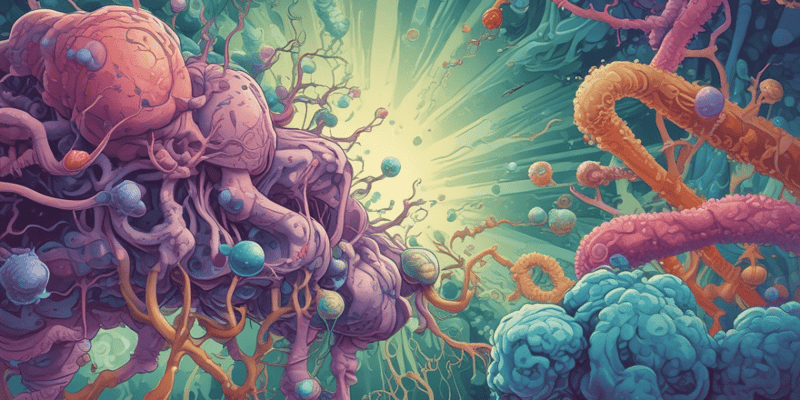Podcast Beta
Questions and Answers
What distinguishes a pathogen from other microorganisms?
Which type of microorganism can grow in both the presence and absence of oxygen?
What is the primary component of the bacterial cell wall?
Which method is NOT commonly used for microbial identification?
Signup and view all the answers
Which classification method is based on the chemical composition of the bacterial cell wall?
Signup and view all the answers
What does the term 'contamination' refer to in microbiology?
Signup and view all the answers
What is the purpose of biochemical reactions in microbiological identification?
Signup and view all the answers
What is a defining characteristic of anaerobic bacteria?
Signup and view all the answers
What is the primary purpose of the Gram stain in microbiology?
Signup and view all the answers
What color do Gram-positive organisms appear after a Gram stain?
Signup and view all the answers
Which feature of the Gram stain provides significant information for the identification of pathogens?
Signup and view all the answers
Why is antibiotic sensitivity testing important in microbiology?
Signup and view all the answers
What does a Gram stain help interpret aside from identifying bacterial species?
Signup and view all the answers
Under which condition is the Gram stain considered particularly significant?
Signup and view all the answers
What limitation does the Gram stain have when interpreting results?
Signup and view all the answers
What was the historical significance of the Gram stain developed by Dr. Gram?
Signup and view all the answers
What is the significance of a Gram stain in microbiology?
Signup and view all the answers
Which color do Gram-positive bacteria appear after a Gram stain?
Signup and view all the answers
Why do Gram-negative bacteria appear pink or red after a Gram stain procedure?
Signup and view all the answers
What does a beta hemolysis indicate on a blood agar plate?
Signup and view all the answers
What is the primary purpose of catalase testing in microbiological studies?
Signup and view all the answers
What is the main benefit of sensitivity testing in microbiology?
Signup and view all the answers
What outcome is indicated by gamma hemolysis on blood agar?
Signup and view all the answers
What characteristic distinguishes Staphylococci from Streptococci and Enterococci in microbiology?
Signup and view all the answers
Study Notes
Microorganisms
- Microorganisms are microscopic living organisms, including bacteria, viruses, and fungi.
- Bacteria are typically 2-5 microns in size.
- Viruses are even smaller, measured in nanometers (10⁻⁹).
Pathogens
- Pathogens are microorganisms that cause disease in humans, animals, or plants.
Infection
- Infection occurs when pathogenic microorganisms invade and multiply in the body, leading to adverse health effects.
Contamination
- Contamination refers to the presence of undesirable microorganisms on materials or surfaces, posing potential health risks.
Bacterial Growth Requirements
- Bacteria can be classified based on their oxygen requirements:
- Aerobic: Grow in the presence of oxygen (e.g., Pseudomonas, Bacillus).
- Anaerobic: Grow in the absence of oxygen (e.g., Clostridium, Bacteroides).
- Facultative Anaerobe: Can grow with or without oxygen (e.g., E. coli).
Bacterial Identification
- Microscopy reveals cellular morphology and structure.
- Culture media provide insight into colony morphology.
- Biochemical reactions differentiate bacteria with similar morphology.
- Molecular techniques identify specific genes.
Cell Wall Composition
- The bacterial cell wall provides shape, rigidity, and protection.
- It is primarily composed of peptidoglycan, a polymer of sugars and amino acids.
- Differences in cell wall composition are the basis for the Gram stain classification.
Gram Stain
- The Gram stain is a differential staining procedure that classifies bacteria based on their cell wall structure.
- Gram-positive bacteria have a thick peptidoglycan layer, appearing purple after staining.
- Gram-negative bacteria have a thinner peptidoglycan layer, appearing red or pink after staining.
Gram Stain Applications
- Quickly assesses the specimen and provides presumptive identification of microorganisms.
- Helps direct antibiotic therapy.
- Interprets the quality of the specimen by assessing the presence of:
- Pus cells (polymorphonuclear leukocytes)
- Epithelial cells
- Bacterial numbers and likely genera
- Distinguishes between colonization (normal flora) and infection.
Gram Stain Limitations
- Not very informative for areas with a lot of normal flora (e.g., throat, stool, decubital ulcers).
- Highly significant for sterile body sites (e.g., cerebrospinal fluid, other body fluids, aspirates from petechiae).
- Assists in interpreting culture results.
Metabolic and Biochemical Reactions
-
Hemolysis:
- Beta hemolysis: Complete destruction of red blood cells, leaving a clear zone around the colony on blood agar.
- Alpha hemolysis: Partial destruction of red blood cells, resulting in a greenish discoloration around the colony.
- Gamma hemolysis: No hemolysis (no change in the appearance of the blood agar).
-
Catalase:
- Tests the organism's ability to break down hydrogen peroxide into water and oxygen.
- A distinguishing feature between Staphylococci (positive) and Streptococci/Enterococci (negative).
- Colonies are placed in hydrogen peroxide; the formation of bubbles indicates a positive result.
Sensitivity Testing (Antibiotic Susceptibility Testing)
- Determines the susceptibility or resistance of bacteria to various antibiotics.
- Guides clinicians in choosing the most effective antibiotic treatment for patients.
Studying That Suits You
Use AI to generate personalized quizzes and flashcards to suit your learning preferences.
Related Documents
Description
Test your knowledge on microorganisms, including their types, growth requirements, and the role of pathogens in infections. Understand the difference between aerobic and anaerobic bacteria and explore the implications of contamination and infection on health.




